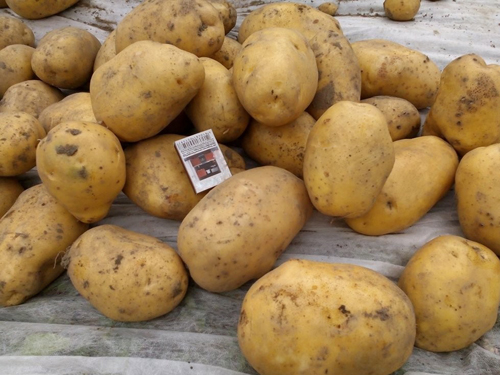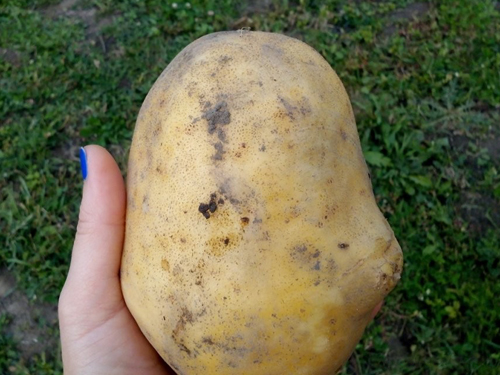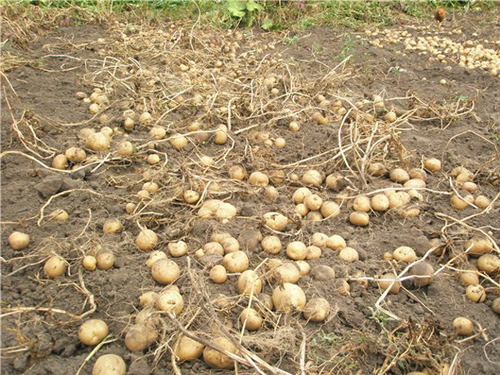Potato variety Santa (Sante)
Sante is a medium-early potato variety (Solanum tuberosum) for table use, bred by the specialists of the Dutch firm "Agrico U. A." In 1993, 9 years after filing an application for admission, it was included in the state register of plants of the Russian Federation under the official name "Sante". Zoned in seven regions of Russia: North, North-West, Central, Volgo-Vyatka, Nizhnevolzhsky, Ural, West Siberian and Far East. Santa is also actively grown in Moldova and Ukraine. The variety is universal, suitable for mechanical harvesting.

The period from germination to harvest is 85-90 days.
Plants are mostly of medium height, sometimes above average. The main stem is erect or semi-erect, the lateral stems are moderately spreading, the green mass is grown in small quantities. The leaves are small, simple, dark green in color. The flowers are large, white, collected in compact corollas.
The tubers are very large, oval or round-oval in shape. The peel is smooth, thin, but rather dense, protects potatoes well from mechanical damage during transportation and storage. Skin color is yellow. The pulp is light yellow and does not darken when cut. The tubers are covered with an abundant number of small, almost invisible superficial eyes.
Santa has a well-developed root system, 15-20 tubers weighing 100-120, and sometimes 150 g are formed under each plant. The yield is high, varying from 300 to 570 c / ha, depending on the composition of the soil and climatic conditions of cultivation.
The taste of this potato is rated as good and even excellent. A feature of the variety is a high dry matter content (20.7), as well as a relatively low starch content in tubers - only about 10-14%. Thanks to this, it is ideal for frying, baking, stuffing and dressing soups, it is an excellent component of vegetable mixtures. But special attention is paid to him in the preparation of French fries. According to some reports, many catering establishments prefer this particular variety for deep-frying. In general, it is highly valued in restaurant cuisine - the tubers cook quickly, do not boil over, retain their shape, and look very attractive. Also tubers are great for making chips and convenience foods. However, it should be said that they are not at all suitable for mashed potatoes.
In addition to its excellent consumer qualities, Santa has another great advantage - it keeps well. Its keeping quality is estimated at 92%, which is a very high indicator. And it should be noted once again that tubers can be transported over fairly long distances without losing their presentation.

The variety is quite picky about the composition of the soil, prefers light fertile soils. There are also some agrotechnical subtleties of growing this potato, without which it will be quite difficult to achieve a large amount of harvest. First of all, it should be said that Santa is a thermophilic plant. Planting is carried out only after the soil has completely warmed up to at least + 8 ° C, approximately in early to mid-May. The second caveat is that the aisles should be wide, at least 60 cm. Below is a short list of other agrotechnical features.
- The planting rate recommended by specialists is 60,000 tubers per hectare.
- The depth of the planting holes must be at least 10 cm.
- The distance between plants should be 30, and if possible 40 cm.
- Should not be planted in the shade - these potatoes love sunlight.
- The plant is hygrophilous, watering is recommended until flowering. But do not overmoisten the soil!
- During the heat, when the air temperature is above 30 ° C, the growth of tubers slows down, so it is worth taking care of shading the plantings and providing them with sufficient moisture. You can also apply mulching.
- Do not forget about applying top dressing to the soil as needed.But care should be taken with nitrogen fertilizers - with an excess of them, the green mass will grow to the detriment of the tubers.
- Do not neglect the timely loosening of the soil, weeding, preventive treatment against pests and diseases, and also support crop rotation.
The value of this variety also lies in the fact that it can be cultivated without the use of chemicals, that is, it is suitable for organic farming. In addition, a huge advantage is the suitability for mechanized harvesting - due to the dense skin, the tubers are not subject to mechanical damage. Thus, the plant fully justifies its universal purpose and can be grown both for large-scale commercial production and for personal consumption.

Santa is resistant to potato nematodes, cancer, viruses and leaf curls. However, it is susceptible to Rhizoctonia (black scab) and common scab. The foliage can be affected by late blight, while the tubers are not susceptible to it. Under unfavorable conditions, black leg disease is possible.
To summarize, it's safe to say that these time-tested Dutch potatoes are sure to delight you with their high yields and excellent taste if you take a little care of them.
The patent holders of the variety are: FGUP "Kotlasskoe", FGBNU "Primorsky Research Institute of Agriculture", FGBNU "Sakhalin Research Institute of Agriculture", FGBNU "Kamchatka Research Institute of Agriculture", FGBNU "Far Eastern Research Institute of Agriculture" farms ", FGBNU" All-Union Research Institute of Potato Farming named after A.G. Lorkha ".
Cultivation is officially carried out by such companies as ZAO Oktyabrskoe in the Leningrad Region, ZAO Teplichny in the Omsk Region, OOO Greenhouse and Greenhouse Plant Elita-Potato in Omsk, OOO Slavyanka-M, Leningrad Oblast, IP Kolyasin Sergey Nikolaevich.








